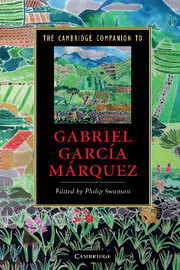Book contents
- Frontmatter
- Introduction
- 1 Gabriel García Márquez: life and times
- 2 The critical reception of García Márquez
- 3 Before One Hundred Years of Solitude: the early novels
- 4 One Hundred Years of Solitude
- 5 An eco-critical reading of One Hundred Years of Solitude
- 6 The Autumn of the Patriarch
- 7 The General in His Labyrinth
- 8 García Márquez’s novels of love
- 9 García Márquez’s short stories
- 10 García Márquez’s non-fiction works
- 11 García Márquez and film
- 12 García Márquez, magical realism and world literature
- Further reading
- Index
3 - Before One Hundred Years of Solitude: the early novels
Published online by Cambridge University Press: 28 September 2010
- Frontmatter
- Introduction
- 1 Gabriel García Márquez: life and times
- 2 The critical reception of García Márquez
- 3 Before One Hundred Years of Solitude: the early novels
- 4 One Hundred Years of Solitude
- 5 An eco-critical reading of One Hundred Years of Solitude
- 6 The Autumn of the Patriarch
- 7 The General in His Labyrinth
- 8 García Márquez’s novels of love
- 9 García Márquez’s short stories
- 10 García Márquez’s non-fiction works
- 11 García Márquez and film
- 12 García Márquez, magical realism and world literature
- Further reading
- Index
Summary
From the start it is necessary to establish that the three novels gathered under the above rubric were written over a period spanning almost a decade and represent a variety of influences and styles that resist reduction to a single type. According to the author, he began work on Leaf Storm (La hojarasca) as early as 1950, when he was living in the northern Colombian locations of Sucre and Barranquilla. Although initially rejected by an Argentine publishing house, the novel eventually appeared in Bogotá, in 1955. In the intervening years, García Márquez published a short story, 'Winter' ('El invierno'), which was filleted out of the larger narrative, in December 1952; he subsequently published it again under the revised title of 'Monologue of Isabel Watching It Rain in Macondo' ('Monólogo de Isabel viendo llover en Macondo') in October-November 1955. Together with the slightly earlier story, 'Nabo: The Black Man Who Made the Angels Wait' ('Nabo, el negro que hizo esperar a los ángeles' [1951]), 'Monologue of Isabel' exemplifies the early influence on García Márquez of William Faulkner, whom he first read in 1949 and whose narrative vision, expressed paradigmatically in As I Lay Dying, underpins the conception and architecture of Leaf Storm. No One Writes to the Colonel (El coronel no tiene quien le escriba, 1958) was penned not in Colombia but in France, where the author was working as a journalist and living in fabled penury, in 1956.
- Type
- Chapter
- Information
- The Cambridge Companion to Gabriel García Márquez , pp. 41 - 56Publisher: Cambridge University PressPrint publication year: 2010
- 1
- Cited by

